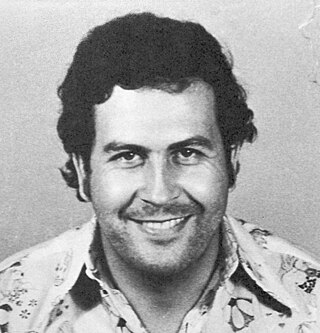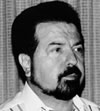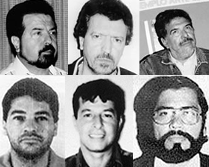
Blow is a 2001 American biographical crime drama film directed by Ted Demme, about an American cocaine kingpin and his international network. David McKenna and Nick Cassavetes adapted Bruce Porter's 1993 book Blow: How a Small Town Boy Made $100 Million with the Medellín Cocaine Cartel and Lost It All for the screenplay. It is based on the real-life stories of U.S. drug trafficker George Jung and his connections including narcotics kings Pablo Escobar and Carlos Lehder Rivas, and the Medellín Cartel.

The Medellín Cartel was a powerful and highly organized Colombian drug cartel and terrorist organization originating in the city of Medellín, Colombia, that was founded and led by Pablo Escobar. It is often considered to be the first major "drug cartel" and was referred to as such due to the organization's upper echelons and overall power-structure being built on a partnership between multiple Colombian traffickers operating alongside Escobar. Other members included Jorge Luis Ochoa Vásquez, Fabio Ochoa Vásquez, Juan David Ochoa Vásquez, José Gonzalo Rodríguez Gacha, and Carlos Lehder. Escobar's main partner in the organization was his cousin Gustavo Gaviria, who handled much of the cartel's shipping arrangements and the more general and detailed logistical aspects of the cocaine trafficking routes and international smuggling networks, which were supplying at least 80% of the world's cocaine during its peak.

Adler Berriman "Barry" Seal was an American commercial airline pilot who became a major drug smuggler for the Medellín Cartel. When Seal was convicted of smuggling charges, he became an informant for the Drug Enforcement Administration and testified in several major drug trials. He was murdered on February 19, 1986, by contract killers hired by the cartel.

Carlos Enrique Lehder Rivas is a Colombian and German former drug lord who was co-founder of the Medellín Cartel. Born to a German father and Colombian mother, he was the first high-level drug trafficker extradited to the United States, after which he was released from prison in the United States after 33 years in 2020. Originally from Armenia, Colombia, Lehder eventually ran a cocaine transport empire on Norman's Cay island, 210 miles (340 km) off the Florida coast in the central Bahamas.

Gilberto José Rodríguez Orejuela was a Colombian drug lord and one of the leaders of the Cali Cartel. Orejuela formed the cartel with his brother, Miguel Rodríguez Orejuela, José Santacruz Londoño, and Hélmer Herrera. The cartel emerged to prominence in the early 1990s, and was estimated to control about 80% of the American and 90% of the European cocaine markets in the mid-1990s. Rodríguez Orejuela was captured after a 1995 police campaign by Colombian authorities and sentenced to 15 years in prison. He obtained early release in 2002, and was re-arrested in 2003, after which he was extradited to the United States. There, he was sentenced to 30 years in prison, where he died in 2022.

Norman's Cay is a small Bahamian island in the Exumas, a chain of islands south and east of Nassau, that served as the headquarters for Carlos Lehder's drug smuggling operation from 1978 until around 1982.
Eduardo Arellano Félix is a Mexican drug trafficker, brother of Benjamín, Ramón, Javier and sister, Enedina, all drug traffickers. The Arellano-Félix Organization, also known as the Tijuana Cartel, has been responsible for numerous murders and the smuggling of thousands of tons of marijuana, cocaine, heroin and methamphetamine for more than a decade. The DEA believes that the Arellano-Félix brothers were responsible for the numerous smuggling tunnels that were found in January 2006.

Jorge Luis Ochoa Vásquez is a Colombian former drug trafficker who was one of the founding members of the Medellín Cartel in the late 1970s. The cartel's key members were Pablo Escobar, Carlos Lehder, José Gonzalo Rodríguez Gacha, Gustavo Gaviria, Jorge Ochoa, and his brothers Juan David and Fabio.

Luis Hernando Gómez Bustamante is a Colombian drug trafficker for the Norte del Valle Cartel, who was arrested in 2004 and, on July 19, 2007 transported for extradition to the United States on charges of money laundering and drug smuggling. Gomez, also known as "Rasguño" is reported to have received his nickname after dismissing the wound caused by being grazed in the cheek by a bullet as "just a scratch". He is currently incarcerated at Federal Correctional Institution, Mendota with a projected release date of 2032.
Jack Carlton Reed, was a drug smuggler and co-defendant of the Colombian drug baron and Medellín Cartel co-founder Carlos Enrique Lehder Rivas. Reed was a pilot working under Lehder’s cocaine transport empire on Norman's Cay, an out island 210 miles (340 km) off the Florida coast, in the Exuma chain in the Bahamas. Reed flew drug runs for Lehder, who handled transport and distribution, while Colombian drug lord Pablo Escobar handled production and supply.
Max Mermelstein was an American drug smuggler for the Medellín Cartel in the late 1970s and early 80s, who later became a key informant against the organization. In the words of James P. Walsh, the U.S. Attorney for Los Angeles CA, Mermelstein "was probably the single most valuable government witness in drug matters that this country has ever known." He became a "weapon for the government". He is reputed to have smuggled 56 tons of cocaine worth $12.5 billion into the United States.
The illegal drug trade in The Bahamas involves trans-shipment of cocaine and marijuana through The Bahamas to the United States.
Carlos Alberto Arellano Félix is a Mexican medical doctor who is known for his illegal involvement in money laundering for the Tijuana Cartel. Carlos was born on the 20th of August in the year 1955 in the city of Culiacán, Sinaloa. Historian Paul Eiss states that Culiacán is the origin of modern drug trafficking and the home of Mexico's most powerful drug cartel. Carlos is currently working as a licensed surgeon. He finished his surgical training at the Universidad Autónoma de Guadalajara The Tijuana Cartel is an organisation that is notorious for being one of the most well-known drug trafficking groups in Mexico to smuggle goods into the United States. Carlos’ family is made up of seven brothers and four sisters who inherited the Arellano Felix Organisation from their godfather, Miguel Ángel Félix. Despite Carlos’ involvement in money laundering for the Tijuana Cartel, he is one of two brothers who remains free and is not wanted by the United States law enforcement.
Michael "Mickey" Munday is an American former drug trafficker and former associate of Colombia's Medellin Cartel during the growth phase in cocaine trafficking, 1975–1986. Munday was featured in the 2006 Rakontur documentary, Cocaine Cowboys.

Drug barons of Colombia refer to some of the most notable drug lords which operate in illegal drug trafficking in Colombia. Several of them, notably Pablo Escobar, were long considered among the world's most dangerous and most wanted men by U.S. intelligence. "Ruthless and immensely powerful", several political leaders, such as President Virgilio Barco Vargas, became convinced that the drug lords were becoming so powerful that they could oust the formal government and run the country.

American Made is a 2017 American action comedy film directed by Doug Liman, written by Gary Spinelli, and starring Tom Cruise, Domhnall Gleeson, Sarah Wright, Alejandro Edda, Mauricio Mejía, Caleb Landry Jones, and Jesse Plemons. It is inspired by the life of Barry Seal, a former TWA pilot who became a drug smuggler for the Medellín Cartel in the 1980s and then, in order to avoid jail time, became an informant for the DEA.
The Miami drug war was a series of armed conflicts in the 1970s and 1980s, centered in the city of Miami, Florida, between the United States government and multiple drug cartels, primarily the Medellín Cartel. It was predominantly fueled by the illegal trafficking of cocaine.
Fabio Benjamin Garcia is a former Colombian drug lord and prison breaker who specialized in the smuggling of cocaine from Colombia to the United States on a substantial scale. Garcia was one of the major figures in the cocaine trade and drug smuggling during the 1980s in the United States and South America. During his peak in the late 1980s, he was a part of two major drug cartels including Cali Cartel and Medellín Cartel, which were responsible for up to 90% of the cocaine smuggled into the United States. In 1989, Garcia and his partner Ian Hall Saxon were found guilty by High Court of Australia in the largest drug bust in the history of Australia.

Ediel López Falcón, also known as La Muela or Metro 5, is a Mexican convicted drug lord and former high-ranking member of the Gulf Cartel, a criminal group based in Tamaulipas, Mexico. He was the regional boss of Miguel Alemán and helped coordinate international drug trafficking shipments from South and Central America to Mexico and the U.S. His roles in the cartel were also to coordinate oil theft operations. In 2012, he was indicted by the U.S. District Court for the District of Columbia for drug trafficking activities. After fleeing Mexico to avoid gang-related violence, López Falcón was arrested in Texas during a sting operation in 2013. He pleaded guilty and was sentenced to 18 years in prison in 2015. He is currently imprisoned at the Federal Correctional Institution, Fort Dix in New Jersey. His expected release date is in 2029.

The cocaine boom was a stark increase in the illegal production and trade of the drug cocaine that first began in the mid to late 1970s before then peaking during the 1980s. The boom was the result of organized smugglers who imported cocaine from Latin America to the United States, and a rising demand in cocaine due to cultural trends in the United States. Smuggling rings of Cuban exiles organized trade networks from Latin America to Miami that streamlined the import of cocaine to the United States. Americans also began favoring less of the drugs popular in the 60s counterculture such as marijuana and LSD, and instead began to prefer cocaine due to a mystique of prestige that was developing around it. This increase in cocaine trade fueled the rise of the crack epidemic and government sponsored anti-drug campaigns.











